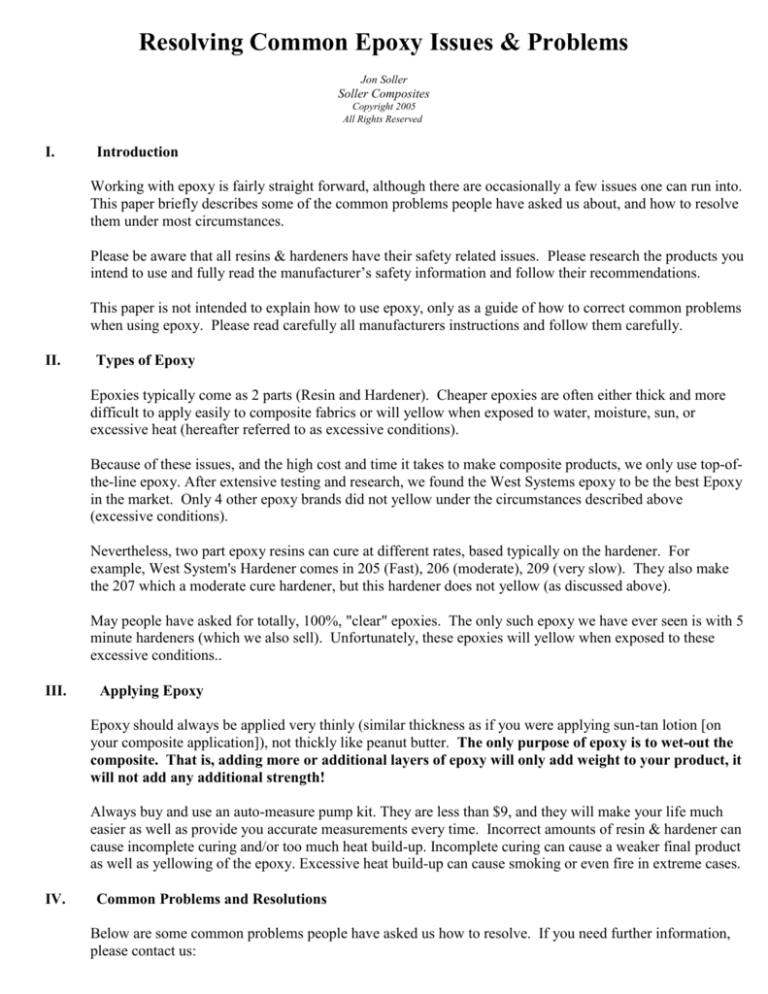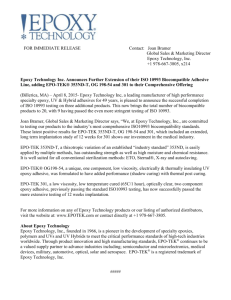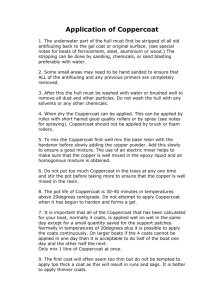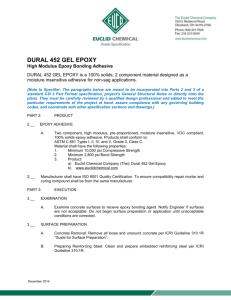
Resolving Common Epoxy Issues & Problems
Jon Soller
Soller Composites
Copyright 2005
All Rights Reserved
I.
Introduction
Working with epoxy is fairly straight forward, although there are occasionally a few issues one can run into.
This paper briefly describes some of the common problems people have asked us about, and how to resolve
them under most circumstances.
Please be aware that all resins & hardeners have their safety related issues. Please research the products you
intend to use and fully read the manufacturer’s safety information and follow their recommendations.
This paper is not intended to explain how to use epoxy, only as a guide of how to correct common problems
when using epoxy. Please read carefully all manufacturers instructions and follow them carefully.
II.
Types of Epoxy
Epoxies typically come as 2 parts (Resin and Hardener). Cheaper epoxies are often either thick and more
difficult to apply easily to composite fabrics or will yellow when exposed to water, moisture, sun, or
excessive heat (hereafter referred to as excessive conditions).
Because of these issues, and the high cost and time it takes to make composite products, we only use top-ofthe-line epoxy. After extensive testing and research, we found the West Systems epoxy to be the best Epoxy
in the market. Only 4 other epoxy brands did not yellow under the circumstances described above
(excessive conditions).
Nevertheless, two part epoxy resins can cure at different rates, based typically on the hardener. For
example, West System's Hardener comes in 205 (Fast), 206 (moderate), 209 (very slow). They also make
the 207 which a moderate cure hardener, but this hardener does not yellow (as discussed above).
May people have asked for totally, 100%, "clear" epoxies. The only such epoxy we have ever seen is with 5
minute hardeners (which we also sell). Unfortunately, these epoxies will yellow when exposed to these
excessive conditions..
III.
Applying Epoxy
Epoxy should always be applied very thinly (similar thickness as if you were applying sun-tan lotion [on
your composite application]), not thickly like peanut butter. The only purpose of epoxy is to wet-out the
composite. That is, adding more or additional layers of epoxy will only add weight to your product, it
will not add any additional strength!
Always buy and use an auto-measure pump kit. They are less than $9, and they will make your life much
easier as well as provide you accurate measurements every time. Incorrect amounts of resin & hardener can
cause incomplete curing and/or too much heat build-up. Incomplete curing can cause a weaker final product
as well as yellowing of the epoxy. Excessive heat build-up can cause smoking or even fire in extreme cases.
IV.
Common Problems and Resolutions
Below are some common problems people have asked us how to resolve. If you need further information,
please contact us:
Epoxy turned cloudy when cured: This is commonly caused by too much moisture either in
the air or moisture has gotten into the epoxy mixture. We have also
seen this when the epoxy is heated with a heat gun and dried too
quickly. Over mixing or overworking the epoxy may cause this as well.
Epoxy gets very hot: This is caused by either making too big of a pot (too much resin &
hardener being mixed together at once, or too much hardener for the
resin amount. Make sure your ratios of resin and hardener are correct.
You can also mix this in a container that has more surface area (bigger
container). Adding more surface area to the epoxy while mixing will
allow for the mixture to stay cooler. The epoxy should get warm, but
never hot.
Bubbles form on the cured epoxy: A few bubbles are normal. This can be avoided by
covering the piece with thick plastic, peel-ply, or release fabric. Too
many bubbles are commonly caused from the epoxy curing too quickly.
Try curing at lower temperatures, or switch to a lower temperature
hardener. You can also try breaking the bubbles as the form with a roller
or a spreader.
Epoxy yellows after cured when exposed to water, moisture, excessive heat, or sun:
Try using the 207 Hardener, and add a clear coat with UV protection
(such as a clear outdoor urethane) .
Can't get that professional shiny look: Spray the final piece with a urethane, enamel, or
other clear coats. Use 3-6 very very thin coats (to avoid sagging and
dripping).
.
If you have other problem, please feel free to contact us. We will be glad to help you!





